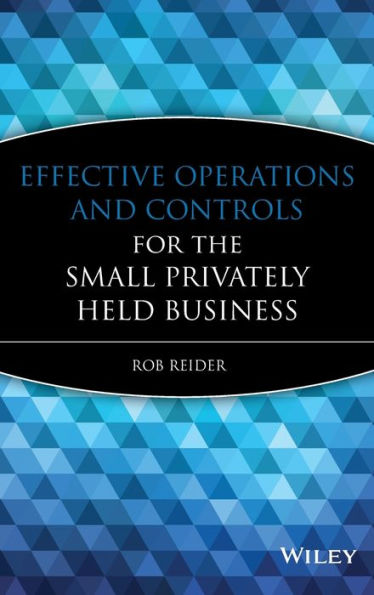Effective Operations and Controls for the Small Privately Held Business / Edition 1 available in Hardcover

Effective Operations and Controls for the Small Privately Held Business / Edition 1
- ISBN-10:
- 047022276X
- ISBN-13:
- 9780470222768
- Pub. Date:
- 01/02/2008
- Publisher:
- Wiley

Effective Operations and Controls for the Small Privately Held Business / Edition 1
Hardcover
Buy New
$80.00Buy Used
$52.49-
-
SHIP THIS ITEM
Temporarily Out of Stock Online
Please check back later for updated availability.
-
Overview

Product Details
| ISBN-13: | 9780470222768 |
|---|---|
| Publisher: | Wiley |
| Publication date: | 01/02/2008 |
| Pages: | 416 |
| Product dimensions: | 6.30(w) x 9.30(h) x 1.22(d) |
About the Author
Read an Excerpt
Table of Contents
Preface xiAcknowledgment xvii
Chapter 1 Understanding the Small Business Environment 1
Understanding the Small Business 1
Small Business Management 4
Small Business Computerization 5
Operational Management Function 7
The Family Business 8
Basic Operating Formula 16
Why the Small Business is in Existence 16
Businesses the Small Business is Not In 17
Helpful Systems 21
Management Responsibility 21
Operating Areas to Be Addressed 22
Economy, Efficiency, and Effectiveness 29
The Initial Survey 31
Chapter 2 Strategic Concepts 35
Strategy Development 36
Strategies for Competitive Advantage 37
Other Strategies to Exploit 40
Business Models 42
Front-End Strategy Analysis 43
Overview of the Strategy Development Process 44
Some Basic Business Principles 49
Mental Models and Belief Systems 50
Situational Analysis: Planning Questions 52
Chapter 3 Planning and Budgeting: Identifying the Right Direction and Staying On the Path 57
Relationship between the Planning and Budgeting Process 58
Planning Process 62
Budgeting Defined 65
Developing and Monitoring the Budget 67
Nonmanufacturing Budgets 68
Conclusion 69
Chapter 4 Improving Customer Service 73
New-Customer Quest 75
Servicing Present Customers 76
Striving for Outstanding Customer Service 78
Golden Rule of Customer Service 88
Looking at Customer Service from a Fresh Perspective 98
Tips for Terrific Touchpoints 100
Tips for Avoiding Traps that Trip You Up 102
Tips for Watching Out for Traps 107
Making that Great Customer Service Last: Keep the Romance in the Relationship 107
Conclusion 108
Chapter 5 Cash Conversion 111
Cash Conversion Basics 112
Cash Conversion Objectives 119
Profitability versus Liquidity 120
Chapter 6 Sales Function 129
Purpose of the Sales Function 130
Sales Function in Business for Itself 132
Product Analysis 133
Sales and Product Controls 135
Sales Forecasts 138
Pricing Strategies 139
Methods of Sales 144
Methods of Compensation 145
Sales Information and Reporting Systems 147
Performing the Sales Function Analysis 148
Sales Function Desirable Practices 149
Conclusion 151
Chapter 7 Cost Considerations 153
Cost Classifications 154
Manufacturing versus Nonmanufacturing Costs 154
Activity-Based Costing Overview 157
Cost Elements 170
Cost Reduction Analysis: Traditional versus ABC 179
Customer Cost Concepts 183
Analysis of Cost Behavior 189
Conclusion 196
Chapter 8 Accounting Operations: Functional Considerations 199
Accouting Function 200
Function Analysis 201
Choosing What to Analyze 202
Financial Reporting 208
Operational Analysis Survey Form 208
Analysis of Functional Costs 212
Developing Recommendations 216
Conclusion 224
Chapter 9 Operational Reporting Considerations 227
Small Business’s Numbers 228
Financial and Operating Ratio Analysis 238
Key Operating Statistics 249
Conclusion 259
Chapter 10 Internal Controls for the Small Business 263
What is Business Risk? 264
Internal Controls as Best Practices 267
Small Business Stakeholders 268
Internal Control Concepts 269
Internal Control Objectives 273
Consideration of Fraud 274
Internal Control Considerations 278
How to Segregate Duties (at a Work or Activity-Unit Level) 285
Performance Measures 286
Internal Control Review: The 12-Step Program 289
Internal Controls for Operations 292
Effective Controls by Type of Business 298
Conclusion 310
Chapter 11 Information Technology Control Considerations 313
Overview of Computer Operations 315
Control Objectives for IT 316
IT Controls 319
Common Small Business IT Control Weaknesses 335
IT Control Examples 337
Developing a Web Site 345
Chapter 12 Organization Structure and the Role of Management 355
Organizing the Small Business 356
Why Organize? 359
Building the Small Business Organization Structure 365
Comparisons between Individuals 369
What is Management? 370
Management Functions 372
Management Skills 374
Why Managers Fail 375
Tools for Self-Appraisal 376
Conclusion 376
Afterword 383
Index 389
